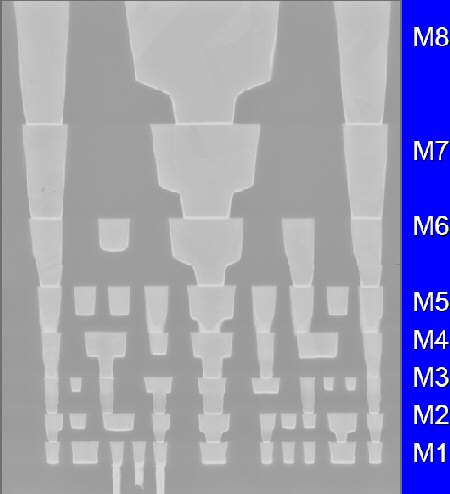The Quest for More Processing Power, Part One: "Is the single core CPU doomed?"
by Johan De Gelas on February 8, 2005 4:00 PM EST- Posted in
- CPUs
CHAPTER 3: Containing the epidemic problems
Reducing leakage
Leakage is such a huge problem that it could, in theory, make any advance in process technology useless. Without countermeasures, a 45 nm Pentium 4 would consume 100 to 150 Watts on leakage alone, and up to burn 250 Watts in total. The small die would go up in smoke before the ROM program would have finished the POST sequence.
However, smart researchers have found ways to reduce leakage significantly. SOI – Silicon on Insulator - improves the insulation of the gate and thus reduces leakage currents. SOI has made process technology even more complex, making it harder for AMD to get high binsplits on the Opteron and Athlon 64. However, it is clear that the Athlon 64 has a lot less trouble with leakage power than the Prescott, despite the fact that the Athlon 64 has only 20% less transistors than the Intel Prescott (106 versus 125 million).
The most spectacular reduction of leakage will probably come from Intel's "high-k" materials, which will replace the current silicon dioxide gate dielectric. Thanks to this advancement and other small improvements, Intel expects to reduce gate leakage by over one hundredfold! This new technology will be used when Intel moves to 45nm technology.
Another promising technique is Gate Bias technology. By using special sleep transistors, leakage can be reduced by up to 90% while the dynamic power is also reduced with 50% and more.
Body Bias techniques make it possible to control the voltage of a transistor. The objective is to make transistors slow (low leakage) when they are not used, and fast when they are. Stacked transistors and many other technologies also allow for reduction in leakage.[4]
One could probably write a book on this, but the message should be clear: the leakage problem is not going to stop progress. SOI already reduces the problem significantly and high K materials will make sure that the whole leakage problem will remain to be a nuisance, but not a major concern until the industry moves to even smaller structures than 45 nm.
At the same time, strained silicon will reduce the amount of dynamic power needed. With strained silicon, electrons experience less resistance. As a result, CPUs can get up to 35 percent faster without consuming more. This is what should allow the Athlon 64 stepping "E0" to reach higher clock speeds without consuming more.
Reducing Wire Delay
Although wire delay has not been so much in spotlight as leakage power, it is an important hurdle that designers have to take when they target high clock speeds. The resistance of wires has been reduced by both AMD and Intel using copper instead of aluminium. Capacitance has been lowered by using lower-K materials separating wires.

Fig 5. 8 Metal layers to reduce wire delay in Intel's 65 nm CPUs
Adding more metal layers is another strategy. More metal layers enable the wires connecting different parts of the CPU to be packed more densely. More densely means shorter wires. And shorter wires result in lower resistance, which, in turn, reduce the total RC Delay.

Fig 6. Repeaters on the Itanium Die
Of course, there are limits on what adding more metal layers, using SOI and lower-K materials can do to reduce RC delay. If some of the global wires are still too long, they are broken up into smaller parts, which are connected by repeaters. Repeaters can be used as much as you like, but they consume power of course.
Now that we have wire delay and leakage more or less out of control, let us try to find out what went exactly wrong with the Pentium 4 "Prescott". The answer is not as obvious as it seems.










65 Comments
View All Comments
AnnoyedGrunt - Tuesday, February 8, 2005 - link
It's possible that 22 was referring solely to the grammar of the sentence, which could potentially make more sense if it was rewritten as, "while other applications will REQUIRE exponential investments in develpment....."Very good article overall, but some portions could be polished a bit perhaps to make it easier for people only slightly familiar with processor details (people like myself) to understand.
Really looking forward to part 2!
-D'oh!
JarredWalton - Tuesday, February 8, 2005 - link
23 - Not at all. Have you ever tried writing multi-threaded code? If it take 12 months to write and debug a single-threaded program that handles a task, and you try to do the same thing in multi-threaded code, I would expect 24 to 36 months to get everything done properly.Let's not even get into the discussion of the fact that not all code really *can* benefit from multi-threadedness. I had a similar conversation with several others in the Dual Core AMD Roadmap article. You can read the comments there for additional insight, I hope:
http://www.anandtech.com/talkarticle.aspx?i=2303
cosmotic - Tuesday, February 8, 2005 - link
"while the other applications will see exponential investments in development time to achieve the same performance increase." Thats a really stupid statement.cosmotic - Tuesday, February 8, 2005 - link
That first image really sucks. You should at least make it look decent. It looks like crap now.IceWindius - Tuesday, February 8, 2005 - link
Math hurts, and thus my head hurts.......Either way, Intel finally admits they fucked up and AMD spanked them for it. Justice is served.
faboloso112 - Tuesday, February 8, 2005 - link
only about halfway through the article but this is a damn good article.not a fanboi of any sort but i certainly do hate intel's pr team.
i think the reason amd has done well for itself is because it doesn't pride itself nor relies of fake product specs and their exaggerated capabilities and scalability...unlike intel...and ill admit...i got cought up in the hype too with the whole 10ghz thing at the time because based on moore's law and how things had been going w/ the clock speed jumps...i thought one day it would be possible...but look at where the prescott stands now...and look at how instead of blabbing about 10ghz..they talk of multi-core cpu.
i think ill stop talking now and return to the article...
erikvanvelzen - Tuesday, February 8, 2005 - link
i eat these sort of articles about cpu's, memory and the like which have references to hardware which i actually use.If you like this, check out these articles by John 'Hannibal' Stokes @ arstechnica.com:
http://arstechnica.com/cpu/index.html
http://arstechnica.com/articles/paedia/cpu.ars
jbond04 - Tuesday, February 8, 2005 - link
AWESOME article, Johan. Good to see someone do some real research regarding the Prescott processor. Keep up the good work!Oxonium - Tuesday, February 8, 2005 - link
Johan used to write very good articles for Ace's Hardware. I'm glad to see him writing those same high-quality articles for Anandtech. Keep up the good work!BlackMountainCow - Tuesday, February 8, 2005 - link
Wow, very interesting read. Finally some stuff based on real facts and not some "Prescott just sux" stuff. Two thumbs up!